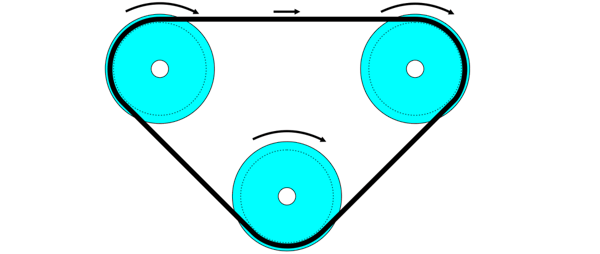Animation Fundamentals: Belts and Chains
Belts
The idea of a belt should be familiar; think of a fan belt. It's similar to a chain, but much easier to implement. Belts can serve multiple purposes.

1. They can transfer rotary motion from one point to another, and is especially useful if the distance is great, and/or the spacing of the end points is not easily controlled, or is even variable.

2. Using different sizes of pulley, a belt can reduce speed. Multiple drive belt assemblies can be combined for greater speed reduction. (In any case of speed change, the smaller pulley is almost always the one that is motorized.)

3. Multiple objects can easily be rotated with a single belt.
4. Belts can create relatively complex two-dimensional motion; imagine an object connected to the belt in figure 3 above; it would trace a triangular shape. Using a variety of pulleys, a myriad of shapes can be created for very complex motions.
5. Belts and chains are somewhat interchangeable with screws, depending on the length, speed, and torque required.
6. A belt can create a dynamic visual effect directly—that is, the belt itself is the animated object. A perfect example of this is the waterfall effect:
|
|
Chains
Chains are much like belts except that more precise alignment and spacing of the hubs is required. Chains have some advantages over belts such as much lower friction and slip-free drive of all hubs along a chain, guaranteeing that all motions are perfectly synchronized. See the Road Compactor for a good example of how chains can be used:
|
|
